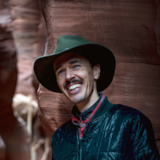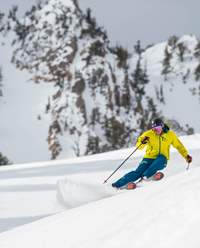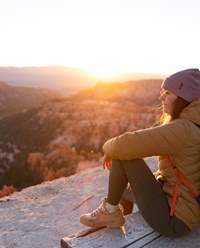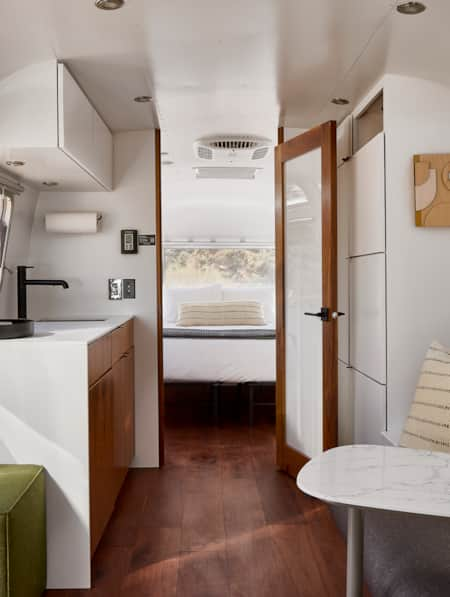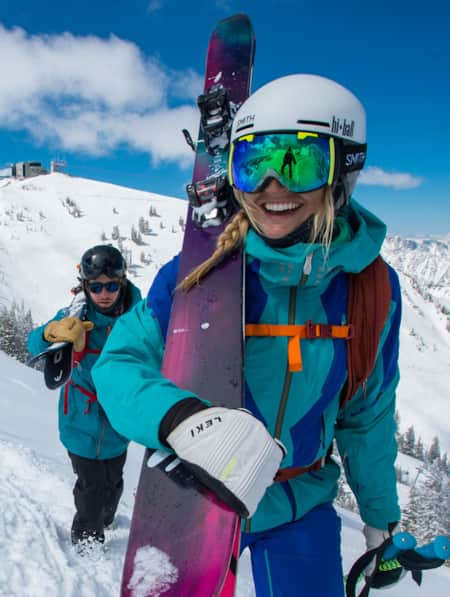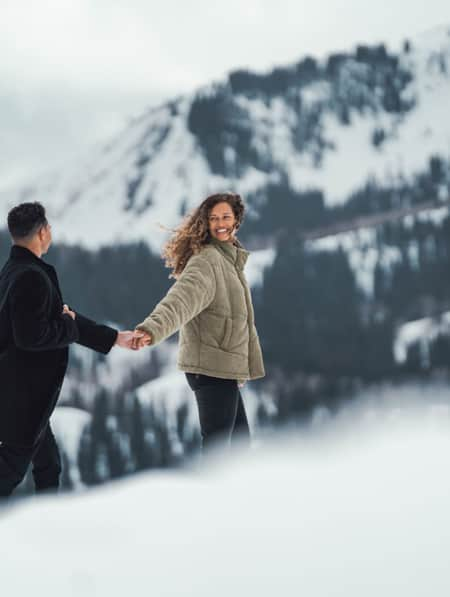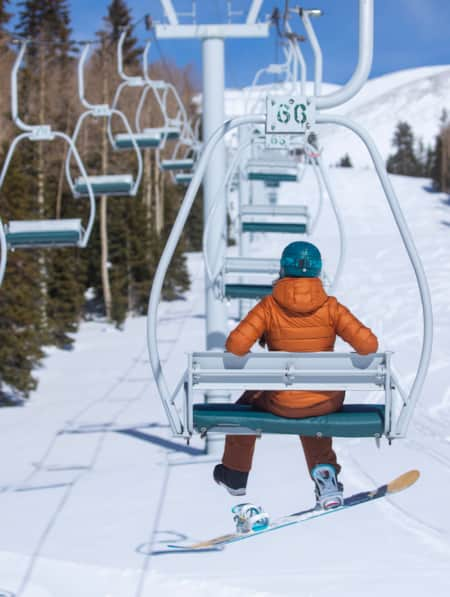Winter in Southern Utah Like a Local
How to plan for an “off-season” trip through Utah's desert landscape.

For many locals, the phrase “winter in Southern Utah” immediately calls up images of red rock under dustings (or blankets!) of fresh snow and blissfully quiet outdoor adventure. For others, the relatively warm climate of the southwest is the setting for some of the state's best — and most visually arresting — year-round golfing. In fact, Southern Utah in winter is both of these. Yet for far too many, Southern Utah in winter is simply the “off-season” — a place where there is far less to do or that isn't accessible. Neither could be further from the truth.
While there may well be fewer people (and occasionally a winter storm worth waiting out before driving over a mountain pass), Southern Utah comes alive in winter with unexpected experiences and unparalleled solitude for those who are well-prepared.
“Don’t be afraid to broaden your search of what you’re going to do on your vacation because you can do some really cool and unique things,” says Patrick Buhr, park manager at Coral Pink Sand Dunes State Park. “People who know about all this are mostly locals.”While some businesses and communities understandably take winter off to rest and enjoy some much-deserved time for themselves, travelers who plan ahead will still find an assortment of cozy towns, well-appointed hotels and resorts and nicely stocked base camps open and ready to lead you on your winter adventure.
A Quick Word on the National Parks in Winter
The national parks anchor many trips to Southern Utah. Winter should be no exception. Whether you’re heading southeast to experience Canyonlands and Arches, southwest to explore Bryce Canyon or Zion, or carefully driving over Boulder Mountain to find the snow-capped monoliths of Capitol Reef, the well-prepared traveler will be thrilled by winter in Utah’s Mighty Five.
From December through February, national parks are part of a much broader winter adventure. Thoughtful, hardy travelers can experience complete solitude, big adventure, a family retreat and even luxurious accommodations with just a little extra planning and attention to current conditions.
"While there may well be fewer people (and occasionally a winter storm worth waiting out before driving over a mountain pass), Southern Utah comes alive in winter..."
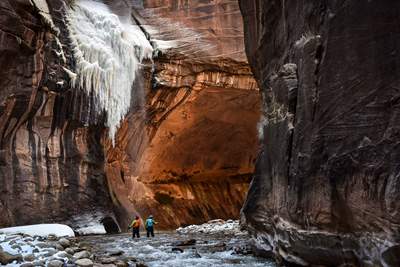
The Southwest Old and New
Thanks to its relatively low elevation, St. George in winter is where the snowbirds fly. The fast-growing, mild-winter city jockeys with Wasatch Front cities for a top-five spot in population and is by far the largest city in all of Southern Utah at around 100,000 people. That fact alone surprises many visitors who envision rugged and remote lands. And that vibrant population translates to an equally vibrant winter.
“We are at 13 golf courses in a 20-mile radius,” says Sara Otto, marketing manager with Greater Zion Convention and Tourism Office. “Nobody believes that I’m in this part of the state that doesn’t get snow very often.”
And even for those familiar with the area from visits during the warmer months, there are surprises in store for winter. Take popular Snow Canyon State Park, where Johnson’s Canyon Trail is only open from mid-September to mid-March to protect summer tortoise migration.
The Greater Zion team also points out winter can be the perfect time for hiking and biking in an area that is often too hot for some outdoor recreation during peak summer months, “You’ll work up a sweat in the warm sun, but quickly be cooled by the mild winter air.”
A base camp in St. George ensures the widest range of guides, outfitters, restaurants, hotels, spas and resort amenities, all blended with easy access to outdoor recreation at Zion National Park, Red Cliffs Desert Reserve, multiple state parks, mountain biking meccas like Gooseberry Mesa and countless other iconic red rock landscapes.
“Here, it’s totally reversed. You don’t hibernate in winter. You come out of the air conditioning and those mild winter temps are ready and welcoming for almost any outdoor activity. And you’re still going to find smaller crowds in places like Zion. Think: The Narrows with snow fluttering down,” Otto says.
Indeed, many Utahns looking to experience their cherished national park in solitude praise the virtues of renting a dry suit in Springdale and grabbing a walking stick for the watery trek up Zion’s famous canyon.
Meanwhile, all roads out of St. George quickly pick up elevation and the contrasts somehow become richer as the landscape spreads outward and upward, climbing the high western plateaus of the Grand Staircase to Cedar Breaks and Bryce Canyon before descending back down the “steps” through multi-hued cliffs to Coral Pink Sand Dunes State Park and the city of Kanab."A base camp in St. George ensures the widest range of guides, outfitters, restaurants, hotels, spas and resort amenities, all blended with easy access to outdoor recreation..."

Mild year-round weather, course variety and world-famous desert topography have long lured Northern Utah snowbirds to St. George.

Winter can be the perfect time for hiking in Snow Canyon State Park.
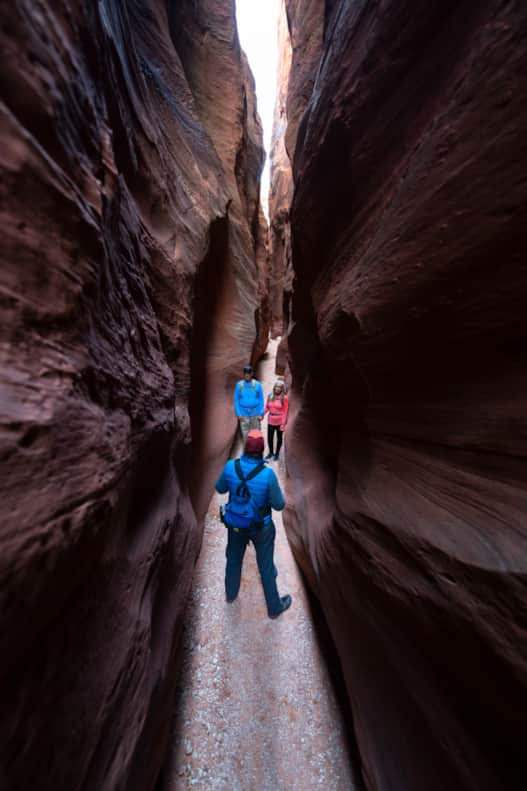
Near Kanab you'll find guide companies offering winter tours of nearby slot canyons.
Photo: Ted Hesser
Adventures in Kanab
In Kanab, Jayme Church owns and manages Adventure Tour Company with her husband, Norris, a sixth-generation guide in Utah. They run their tours all winter, including the popular Peek-a-Boo slot canyon tour, and their “Campfires S’mores and Star Gazing” tour to a private canyon and old Western movie set.
“The night sky in winter is amazing. We border the [Kaibab] Paiute tribe, and they’ve been designated a Dark Sky Nation,” Church says. “Everybody is like, ‘I’m sure you’re used to this’ and I say, ‘No, I’m not. I’m not used to this.’ Every sunset I see or any really amazing starry sky, I am always amazed. I don’t think it ever gets old for me.” (Read: Stargazing in Utah)
The small town also boasts some of the region’s best restaurants and an array of holiday and winter celebrations, including the popular hot air balloon launch, Balloons and Tunes.
“We really do have a lot of stuff going on in Kanab, and I actually really enjoy getting out,” says Church. “[In] the winter I have more time to visit these places. And every time I go, I find three more places that I need to go, so I just keep adding to the list.”
This from someone who hikes year-round and makes trail maps for the county. (Read: 15 Must-Do Adventures in Kanab)
In addition to an abundance of winter hikes, including some accessible on foot from Kanab hotels, don’t miss the nearby Coral Pink Sand Dunes State Park. The park sits at an elevation of 6,000 feet and occasionally gets snow, but it’s open year-round to OHV riding, hiking, even sand (or sometimes snow) sledding.
“We’re a different kind of sand dunes,” says Buhr. “We get people that hike all over in the sand dunes out here. We have really unique features: a big cliff on one side of the dunes, a random grove of giant ponderosa pines. The color of sands and the ponderosa trees are super popular for photography.”
And, of course, you might even see Bigfoot at Coral Pink Sand Dunes. If you do, be sure to grab a selfie.
"In addition to an abundance of winter hikes, including some accessible on foot from Kanab hotels, don’t miss the nearby Coral Pink Sand Dunes State Park."
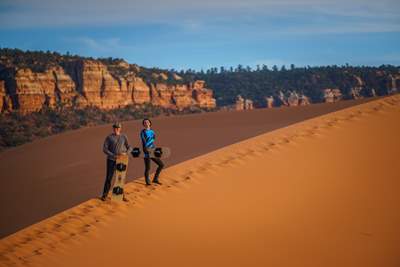
Secluded South-Central Utah
The central part of Southern Utah is never-ending horizons, rolling plateaus of red rock and remote mountain ranges. It’s Capitol Reef National Park, Grand Staircase–Escalante National Monument and Bryce Canyon National Park set among state parks and other lands.
Come winter, part of the region feels all but forgotten. That makes some sense. Locals remember that the now Instagram-famous Boulder, Utah, has claimed to be the last community in the lower-48 to receive mail by mule. Whether that’s true, the last segment of Utah state Route 12 wasn’t even paved until 1985. Few people had even heard of the Grand Staircase until its designation as a monument in 1996. But by 2002, the Federal Highway Administration designated all 124 miles of Route 12 an All-American Scenic Byway.
Yet with the nearly 10,000-foot pass of Boulder Mountain to the north and the snowy heights of Bryce Canyon to the southwest, the Grand Staircase-spanning route is less appreciated in winter. Make no mistake: its remoteness means many businesses close up shop for the winter, including in bustling summer gateways like Escalante or Torrey, the gateway to Capitol Reef. Search online and call ahead to make sure you know what’s open. Capitol Reef in winter, to be sure, is majestic. See ghostly orchards of leafless trees harboring the promise of spring bloom and normally jagged and fractured red rock somehow softened by a thin blanket of snow. (Read: Winter Road Trip: Where to Stay, Hike and Eat When Traveling from Capitol Reef to Bryce Canyon)
And though snow or ice on Boulder Mountain may recommend waiting out the winter storm, plan on making that scenic drive southwest on Highway 12. From there, a base camp at Bryce Canyon City provides ample accommodations and supplies for your winter visit.
And let’s be clear: the road from Bryce Canyon City to Bryce Canyon National Park begins at over 7,600 feet above sea level. Depending on the time of year, that can translate to pillars of snow atop the park’s famous red rock hoodoos, scenic snowshoe hikes and family-friendly winter festivals. But winter in Southern Utah is anything but predictable and solitary hikes on snow-free and empty trails are also possible throughout the season. Even the scenic byway into the park — that climbs up to 9,000 feet by Yovimpa Point — is typically open after snow plow operations. Point being? Peaceful hiking on the family-friendly Bristlecone Loop Trail with views for days in the thin, high-elevation air.
On the western end of Highway 12 is the area’s largest city, Panguitch, where visitors will find additional restaurants and accommodations."The road from Bryce Canyon City to Bryce Canyon National Park begins at over 7,600 feet above sea level. Depending on the time of year, that can translate to pillars of snow atop the park’s famous red rock hoodoos, scenic snowshoe hikes and family-friendly Winter Festivals."
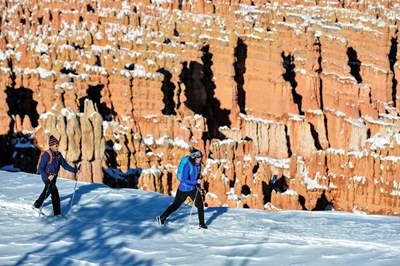
Southeast on the Map: Utah’s Canyon Country
Make no mistake: Moab is on the map. The internationally known gateway to Arches and Canyonlands national parks is one of Utah’s most famous towns, and with good reason: it is an ideal base camp for the two national parks, Dead Horse Point State Park and the vast expanses of wide-open red desert landscapes.
Jennifer Jones is the assistant field manager for recreation for the Bureau of Land Management, Canyon Country District, Moab Field Office. She hopes visitors take a closer look at those lands beyond the main destinations.
“A lot of visitors come to the Moab area to see a particular geologic feature, or to hike a particular canyon,” says Jones. “And my hope is they come away from that experience not only seeing what they came to see, but being impressed by how much more there is… [and taking advantage of] those opportunities to explore things they didn’t even know existed.” Boiled down? “Prepare for variety.”
The town’s popularity also means that over the years, more lodging and restaurants have stayed open year-round. Moab’s winter weather is typically sunny, though cold. Temps drop below freezing overnight. The vast majority of winter visitors won’t be comfortable camping and that’s okay: winter room rates are often more attractive and you’ll appreciate a warm place to unwind after the sun sets. That means the primary challenges for visitors are to monitor weather, road conditions and trails and to pack and plan accordingly, including provisions in your pack and car in the event you get stuck.
“All of the classic hikes, all of these trails, are available and accessible to varying degrees depending on the weather conditions,” says Jones. “People certainly have to be mindful of slickness that comes with snow. It’s not called slickrock for any reason other than it does become slick. It is porous sandstone.” (Read: Winter in Moab)

A winter hike at Dead Horse Point State Park near Moab provides stunning views of the Colorado River, La Sal Mountains and incredible scenery all around.

Don't forget southeastern Utah this winter, where you'll find idyllic sandstone structures and solitude at the Valley of the Gods.
Go Beyond Moab
Drive further southeast, and things change — dramatically.
Jared Berrett founded Bluff Dwellings Resort and Spa with his wife, Spring, and occasionally still moonlights as a guide for their Wild Expeditions. This year for the first time, Berrett, general manager Dallin Tait and the rest of their team are keeping the hotel and services open for the winter season. They’re also continuing to run their land-based adventures through Wild Expeditions such as winter hiking and side-by-side RZR tours at Bears Ears National Monument.
Berrett has a message for prospective travelers: “Don’t forget southeastern Utah in winter. There’s so much to discover here and southeastern Utah doesn’t end in Moab. In fact, I would argue it begins after Moab.”
He says the primary things they promote are solitude and wilderness. It’s why they chose Bluff, Utah, which has a total permanent population of about 200 people. But they promote that solitude alongside their tour company’s four core values: enjoy, educate, preserve and protect.
“Bottom line: there’s still a place where you can find real peace and beauty and feel like you are the only one discovering it within hundreds of miles. It’s not always the case, but the wintertime just amps it up a few notches. You probably won’t see another car all day, even out on Highway 95 in the heart of Bears Ears,” Berrett says.
And like the other regions, the shorter days open up the night skies for premium stargazing no matter where you are. Bears Ears, yes, but also Hovenweep National Monument, Monument Valley Navajo Tribal Park, Goosenecks State Park and more.
But, the towns are smaller and the services limited. Those limited services mean a couple of things: be self-sufficient, or plan ahead so that you understand what is open and accessible. And keep in mind that no matter the season, the Bears Ears region is still extraordinarily undeveloped.
For Tait, that’s okay because it’s about responsible discovery.
“When you come out here in the wintertime, you’re not going to see people. And in those canyons, you’ll feel like the Ancestral Puebloans who built those cliff dwellings: you’ll feel like those were the last people that were there. It’s so remote and quiet, it feels like you’re discovering something for the first time — like humans haven’t seen these places in hundreds of years.”With all that seclusion, it’s easy to feel equally inspired and overwhelmed. For travelers making the trek into the extreme southeast of Utah, you can still take comfort in knowing that Bluff Dwelling’s 104-degree hot tub is waiting for you. Or, if you’re so inclined, a quick “polar plunge” in the pool.
"Shorter winter days open up the night skies for premium stargazing no matter where you are. Bears Ears, yes, but also Hovenweep National Monument, Monument Valley Navajo Tribal Park, Goosenecks State Park and more."
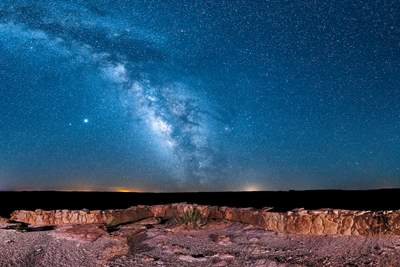
-

Alpine, Après and Arches
Timed perfectly for winter, this journey takes you to some of the finest mountain resorts in the world, then to the most spectacular vistas of the scarlet-hued desert.
-

A Winter Trip Through the Heart of Utah’s Desert
Experience a world unlike anything you’ve ever imagined in the high desert mountains and plummeting canyons of south-central Utah. You’ll step into two national parks, three state parks, and all the scenic winding roads your heart could desire.
-

Winter Aglow in Southeastern Utah
Find your sense of adventure and awe in the vast yet intricate swaths of desert from Arches National Park to Monument Valley. From delicate river-fed ecosystems to crimson-hued rock buttresses, this magical landscape is awash in history, dating back thousands of years to the original Native American settlers to whom these places were sacred.


